It’s almost deer hunting season. Hunters and landowners head out to the ranch or hunting lease to begin the fall ritual of filling feeders and putting out game cameras. When landowners and hunters take to the field, they occasionally find whitetail with various deer diseases that afflict the species we so love to manage and hunt. Questions will often start with “can you tell me what is wrong with the deer in this picture.” Many times these observations occur from trail cameras photos or after a deer was harvested.
Deer disease and parasite issues are not uncommon and hunters run across this sort of thing from time to time. Most of us may not know what disease may be affecting a deer, but we definitely know something is wrong. Just like us, whitetail deer are prone to one sort of illness or another. This is how nature makes the deer population stronger (survival of the fittest). Below are a few of the common whitetail deer disease and health concerns that are often encountered this time of year.
Cutaneous Fribroma – Virus that Effects Skin
Cutaneous fibromas, or deer warts, are hairless tumors caused by a virus and are found on the surface of the skin of infected deer. They can appear anywhere on the body and are usually temporary. Their size varies and can become quite large causing them to crack and bleed. When they do, secondary bacterial infections can occur. No reports of cutaneous fibroma in humans are known. The meat is safe to eat provided no secondary infection is occurring.
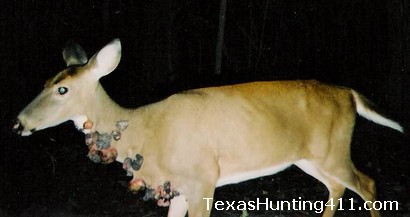
Most deer with fibromas or warts will not be as severe as the deer in the photo above. Most deer that hunters see with fibromas will have one up to a few. However, there are extreme cases and deer can have 50 percent or more of their body covered in fibromas! These deer will potentially suffer from secondary infections.
Epizootic Hemorrhagic Disease and Blue Tongue in Deer
Hemorrhagic disease in deer can be caused by one of two viruses, epizootic hemorrhagic disease (EHD) virus or bluetongue (BT) virus. The virus is spread by a small, biting midge fly (Culicoides). Signs of active disease in deer are variable, but can include depression, fever, irregular breathing, and swelling in the head, neck, and/or tongue. On occasion, animals can become disabled for weeks by lameness or poor body condition. Deer that die from EHD/BT will often die in or around water, trying to cool the fever the disease brings on.
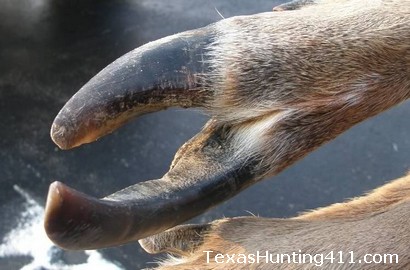
EHD and BT are usually summertime deer diseases but can be observed in late fall, if it is warm. Cooler weather, such as that during the general deer hunting season, typically causes the flies to die back and become less active. Animals that do not succumb to the disease can exhibit hooves that have been sloughed or become elongated due to growth interruptions at the point of the foot where the hoof is devel-oping. Neither of these viruses is infectious to humans. As with other diseases dis-cussed here, the deer is safe to consume barring any additional infections.
Ticks and Keds – Deer Parasites
Most hunters have harvested a deer at one time or another and noticed ticks on the carcass. Ticks do not generally cause health issues for deer unless a heavy infestation is occurring. During these infestation events, fawns can have an increased mortality due to anemia, and secondary infections can occur in adults at the bite site. In cases of secondary bacterial infections the meat should not be consumed. Precaution should be taken when handling carcasses when ticks are present since some species of ticks can carry diseases, such as lyme disease, known to infect people.
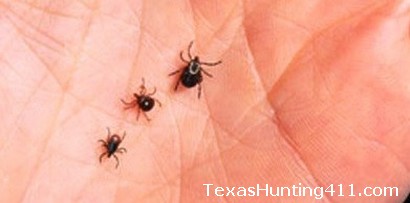
Keds are an insect found on deer. They are mentioned here because they are often misidentified as ticks. They are distinguished from ticks by the number of legs (keds have 6 legs, ticks have 8). Keds have no health implications for deer or people.
Food Impactions – Not Exactly a Deer Disease
Food impaction (lumpy jaw) is a condition illustrated by a large lump of vegetative material found under the skin in the jaw area of a deer. The cause of food impaction is not clearly understood, but is believed to be associated with the presence of an arterial worm (Elaeophora schneideri). Arterial worms live mainly in the carotid artery, but will occasionally be found in smaller arteries in the limbs. When they make their way to arteries in the jaw, food impactions are believed to occur.

No known human health risks are associated with arterial worms. Deer can recover from these impactions and the meat is safe to eat provided there are no additional infections occurring in the body.
Nasal Bots – Also Not a Disease
This is one that is commonly seen. Nasal bots are the larval form of a fly found in the Genus Cephenemyia. The fly will lay a cluster of eggs around the nose and mouth of a deer. The eggs hatch and the larvae migrate into the nose to grow. They eventually make their way into skin folds in the back of the deer’s mouth called the retropharyngeal pouches.
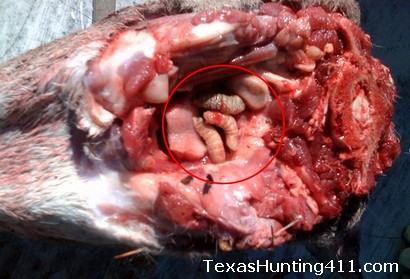
When the larvae are fully grown (approximately 3/4 to 1 inch), they migrate back out of the deer’s nose into the ground to finish developing into an adult fly. These fly larvae pose no threat to the deer and are only a minor nuisance to the host animal. They pose no risk to humans and the meat is not affected, so it is safe to consume. Most deer will have nasal bots in Texas. Commonly seen exiting a deer’s nose after the animal is dead. Can also be encountered in the back of the esophagus when cutting off the head (photo).
Chronic Wasting Disease in Deer
Chronic Wasting Disease (CWD) is a neurological disease in whitetail deer, mule deer, elk, moose and other members of the deer family, known as cervids. The disease was first recognized mule deer in 1967 in Colorado. This disease is not yet widespread in Texas, but it does present numerous challenges for state wildlife agencies across North America. Of concern is the potential for significant declines within deer, elk, or other susceptible cervid populations.
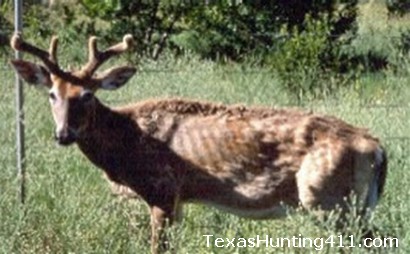
Because eradication is nearly impossible once CWD becomes established in a population, it is imperative that a sound CWD management program is established to reduce the severity of implications resulting from the disease. CWD in Texas is a new one. Itwas found in far west Texas in 2012, near the Texas-New Mexico border.
Deer are wild animals that are really tough. We’ve had diseases over the years on property that we own, mostly bluetonuge. It will take it’s toll on the herd, but they bounce back rather quickly. The best bet is to keep a close eye on the animals and not over react. Good list of the common diseases that whitetail get.
Check out what bot fly larva and what they do to a cantalope or watermelon in a compost pile. They eat the melon like a brain and leave a nice maze of rows or paths. Could they also do this to the brain?
Tammy, bot flies use deer more as a host for reproduction and I think have zero ability to live within the interior of an animal, in the absence of oxygen. Thinking about it kind of freaks me out, though.
I have been hand feeding a deer for over a year, of course not everyday. She is a wild animal, but will trust me enough especially if I have apples, pears or a banana. Last year I noticed a small circular thing on her leg that grew. A few week ago it was the size of a large grapefruit. It with broke open or was ripped open, it has taken a week and a half for the thing to fall off and start healing. Last year she had a doe the had a funny marking by her eye. Now that she is one I can see it growing and she has at least four more all on one side of her body. Do these sound like the warts? The baby will come within five feet of me, but she is not as trusting as her mother. I am not a hunter just a lover of animals. We live in Weirton, WV.
Christine, it’s difficult to determine exactly what you are seeing. Sounds like it could have been an infection, probably from getting cut or poked by something in the deer’s environment, but it must have run its course.
Nice job! Thanks for providing hunters with helpful information on diseases. I would love to see more helpful articles like this.